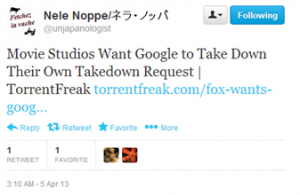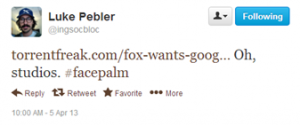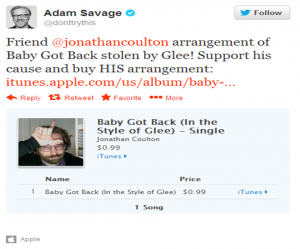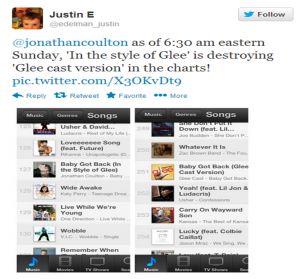As I wrap up my current project on industry’s recruitment and normalization of particular fans and fan practices and begin the pivot to the next project, which is about musical intertexts in remix, mash-up, and cover songs, I have had the good fortune of discovering several interesting things to talk about.
First, I came across the musical genius of Jimmy Fallon, both the series in which he and The Roots join a musical guest to do a rendition of their hit song with children’s musical instruments (e.g. Mariah Carey’s “All I Want for Christmas is You”) and his outstanding impressions (compilation), both of which will be great to talk about in terms of transformative use. All of that is definitely going in the book.
And then came what Paul Barrett at Businessweek called “a really apologetic lawsuit” from pop star Robin Thicke (who did a Jimmy Fallon children’s instrument rendition of “Blurred Lines”) against the heirs of Marvin Gaye.
The backstory is that Gaye’s heirs feel that Thicke’s hit “Blurred Lines” infringes on Gaye’s song “Got to Give it Up” (and Funkadelic’s “Sexy Ways,” though the Gaye estate has no standing on that claim) and threatened to sue if they weren’t paid royalties. In response, Thicke preemptively sued to have “Blurred Lines” declared not infringing.
Media and law scholar Siva Vaidhyanathan notes in his Copyrights and Copywrongs: The Rise of Intellectual Property and How It Threatens Creativity that “Federal courts ask two questions to determine whether a song infringes on the copyright of an earlier song. The plaintiff must show that the second composer had access to the first song and that the second song shows ‘substantial similarity’ to the first” (p. 127).
Barrett’s piece says “The songs are definitely similar: heavy bass line, falsetto vocals, lots of loose percussion and background noise. They’re fun and bouncy.” He adds, “If that constitutes a copyright violation, Thicke and his colleagues are on the hook.” My own analysis (untrained, which I’ll need to fix before I write this next book) leads me to think that there may be a claim for infringement on the bass line, but if the notes and arrangement of that are not in fact similar there’s no case.
Vaidhyanathan tells us that “Copyright regulates (but does not necessarily forbid) performance, transformative works, slight and oblique reference, and even access” (p. 125), and that “slight and oblique” part is where Thicke may be in trouble.
However, the things that are similar between the two songs—the rhythm, the “feel”—are not things copyright is very good at protecting, for better or worse. As Anne Barron noted in Introduction: Harmony or Dissonance? Copyright Concepts and Musical Practice, for a special issue of Social & Legal Studies, “Copyright law, it is said, adopts a narrow conception of music [ . . . ]. It tends to equate music with a score, or at least only protects what can be easily notated in the form of a score. One consequence of this is that it privileges certain musical elements that happen to be important in ‘classical’ music—notably melody and harmony” (p. 26).
However, the law has a “poor vocabulary” when it comes to “rhythm, pitch, nuance and gradation outside the steps of the diatonic/chromatic system, as well as vocal inflection and timbre” or “non-standard pitches and non-discrete pitch movements (e.g. slides, slurs, blue notes, microtones); irregular, irrational rhythms and rhythmic details; nuances of ornamentation, accent, articulation and performer idiolect; and the sound qualities enabled by new techniques developed in the recording studio” (p. 30-1).
So, the kinds of things that are similar across the two seem to fall into that category of things that’s poorly protected. Even if colloquially we can “hear” similarities between the two compositions, even if, as one comment on the Businessweek piece claimed, “Thicke said in an interview that Marvin Gaye’s song was the inspiration for Blurred Lines and that he wanted to write a song like Got To Give It Up,” that doesn’t necessarily add up to copyright infringement in the eyes of the law.
Barrett quotes the lawsuit as saying, “Plaintiffs, who have the utmost respect for and admiration of Marvin Gaye, Funkadelic, and their musical legacies, reluctantly file this action in the face of multiple adverse claims from alleged successors in interest to those artists,” and that’s another interesting twist.
There’s been a good deal of work on sampling (which my upcoming project builds on to ask similar questions about remix, mash-up, and cover songs) that argues that to sample something is to say “‘Hey, I dug this, too” (Vaidhyanathan p. 136).
To use a sample, Barron says, is not to take a “shortcut,” but a way of referencing the sample’s “cultural references and resonances, its status as a kind of aural icon that gathers together a network of associations and experiences [ . . . ]. The value of what is taken in these circumstances is deemed to lie as much in its place within the collective memory of a community of listeners as in the creativity of an author.” (p. 34).
This seems to be the same logic that informs Thicke’s engagement with the respective work of Marvin Gaye and Funkadelic: I like this thing. I want to show that I like it and participate in its tradition while I am doing something new.
Of course, power differentials matter in all this. David Hesmondhalgh’s Digital Sampling and Cultural Inequality uses the example of how Moby sampled African American blues musicians in a way that relied on his privilege and their unprivilege to contend that responses to sampling have to account for such inequalities.
While, as Vaidhyanathan notes, sampling can be “a political act—a way of crossing the system, challenging expectations, or confronting the status quo” (p. 136), this isn’t true of every sample, only those where the powerless take from the powerful, as with Schoolly D sampling Led Zeppelin, whose guitarist The Simpsons called “one of the greatest thieves of American black music to ever walk the earth.” When Moby or Jimmy Page did it to blues musicians, that is, it meant something very different.
Thinking through these issues in other forms of musical intertextuality, in the Thicke case it’s important to think about what it means for a white musician (he’s the face of the song even if it was co-written by African American artists) to be drawing on the style of a black musician (giving credit) while managing to skirt the requirements of law for actually paying that musician’s heirs.
And in that these are exactly the kinds of things I’m interested in in this new project—how musical texts reference older ones, with what purpose, and how this is inflected by law, economics, and racial and gender inequality—it’s really exciting to get to see them playing out in real time, and I’ll be following this case closely.






